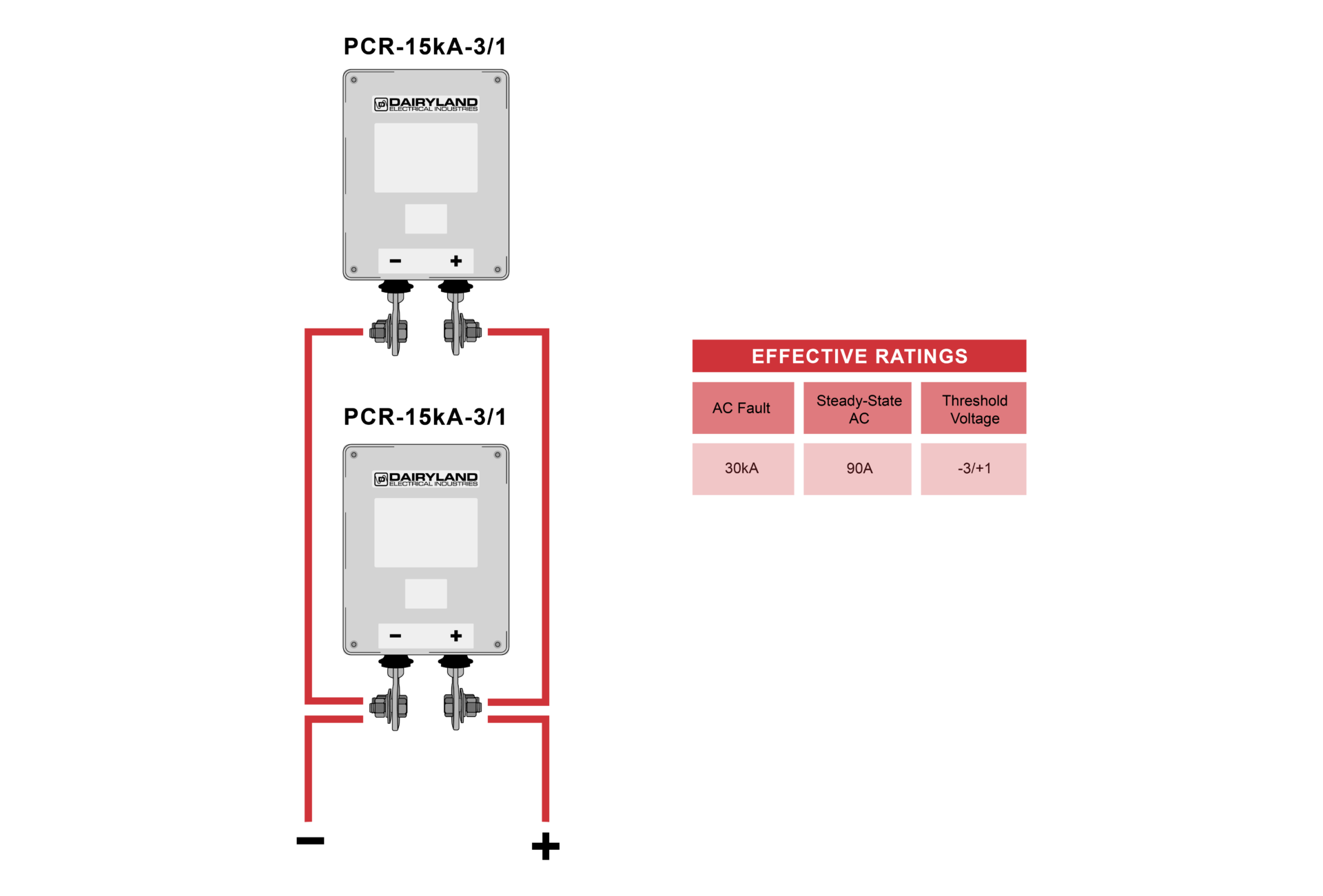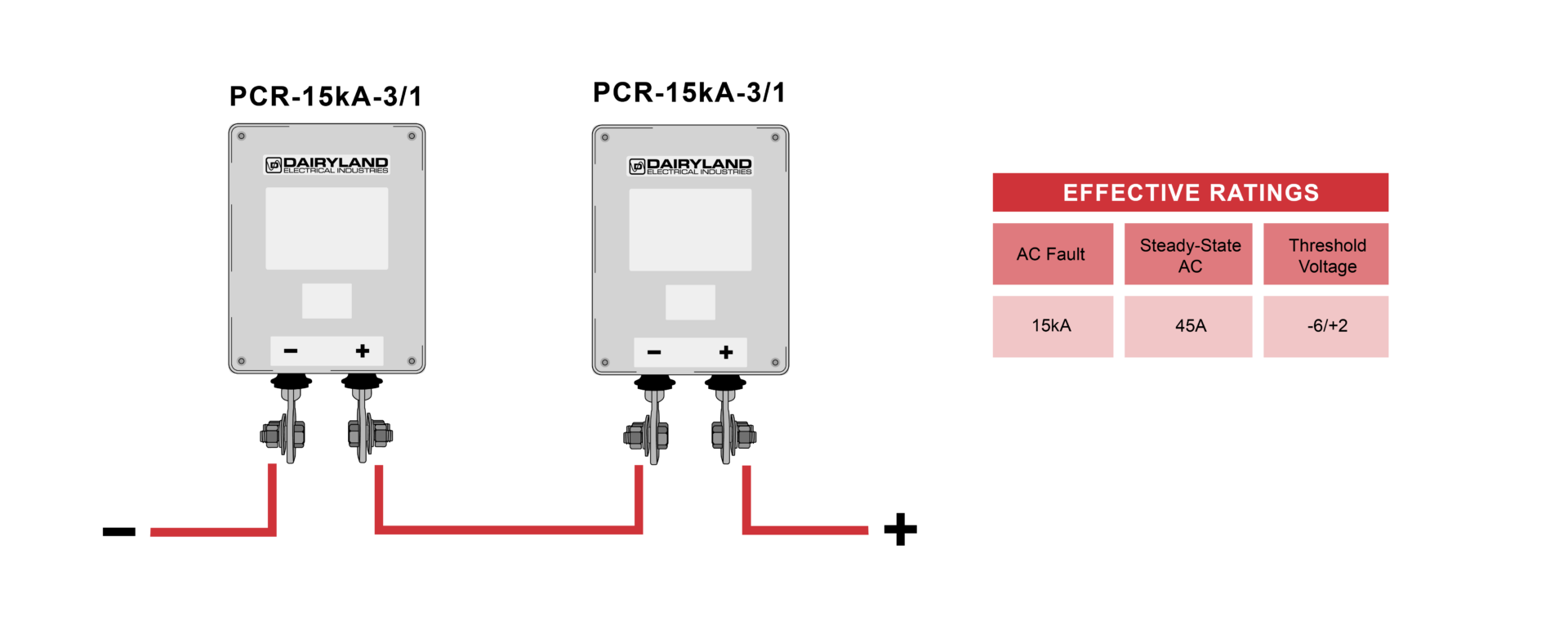Combining Multiple Decouplers To Create Different Effective Ratings
Though not common, sometimes, an application may require a rating higher than what is available as a single decoupler. For example, an AC mitigation project may call for decouplers rated for AC fault currents up to 20kArms. But the highest fault current rating in a single Dairyland decoupler is 15kArms. Similarly, a pipeline may have very high AC interference such that the continuous AC current through a single decoupler may exceed the standard steady-state rating of 45Arms. And occasionally, pipelines with higher CP potentials or those exposed to DC interference may require decouplers with higher threshold voltages to prevent them from going into conduction unnecessarily. Dairyland offers threshold voltages up to -6/+1V on some PCR models. But in some rare cases, even higher thresholds may be needed.
In such applications, multiple decouplers may be combined to create a wide range of effective ratings for AC fault current, steady-state AC current, and threshold voltage that otherwise may have been outside the application range of standard decouplers.
Increase Effective AC Steady-State and Fault Current Ratings by Connecting Multiple Decouplers in Parallel
The effective rating for both AC fault current and steady-state AC current increases in proportion with the number of decouplers connected in parallel. For example, the combination of two standard PCR-15kA devices, when connected in parallel in close proximity (i.e., connecting leads < 1m) as shown in Figure 1, has an effective AC fault current rating of 30kArms @ 30 cycles (50/60 Hz) and an effective steady-state AC current rating of 90 Arms. The threshold voltage of the combination remains unchanged from that of each individual device.

Figure 1. Increasing Effective Current Ratings by Connecting Devices in Parallel
CAUTIONPCRX decouplers should never be combined in parallel
|
When installed in this way, both the fault rating and the threshold voltage of each device must be equal to ensure that they each conduct in unison. Note that the total AC impedance of the parallel decoupler combination is reduced according to Equation 1. For example, the impedance of a single SSD or standard PCR at 60 Hz is 0.010 Ω. When two SSDs are combined in parallel, the equivalent impedance becomes 0.005 Ω at 60 Hz.

Increase Effective Threshold Voltage by Connecting Multiple Decouplers in Series
The effective threshold voltage of the series combination of decouplers is additive with the number of individual decouplers. For example, the combination of two PCRs, each with a threshold voltage of -3/+1V, when connected in series in close proximity (i.e., connecting leads < 1m) as shown in Figure 2, has an effective threshold voltage of -6/+2.

Figure 2. The effective threshold voltage of decouplers combined in series is the sum of the individual device threshold voltages
Note that the effective AC steady-state current rating and AC fault rating of the series combination will be equal to that of the lowest rated device in series.
Be aware that the total AC impedance is additive with the number of decouplers in series. For example, two SSDs or standard PCRs, each having AC impedance of 0.010 Ω at 60 Hz, will have a total impedance of 0.020 Ω at 60 Hz.
Other Ratings Created by Different Decoupler Arrangements
Though their use may be limited, note that several other interesting effective threshold voltages can be created by reversing the polarity on one of the decouplers and connecting them in either anti-series or anti-parallel as shown in the table below.

If you have any questions about combining multiple decouplers or Over-Voltage Protectors, contact Dairyland at techsupport@dairyland.com.
Want To Dive Deeper?
Join One of Our Learning Events.
Our event schedule provides you the in-depth product and application training you need to correctly apply Dairyland products.